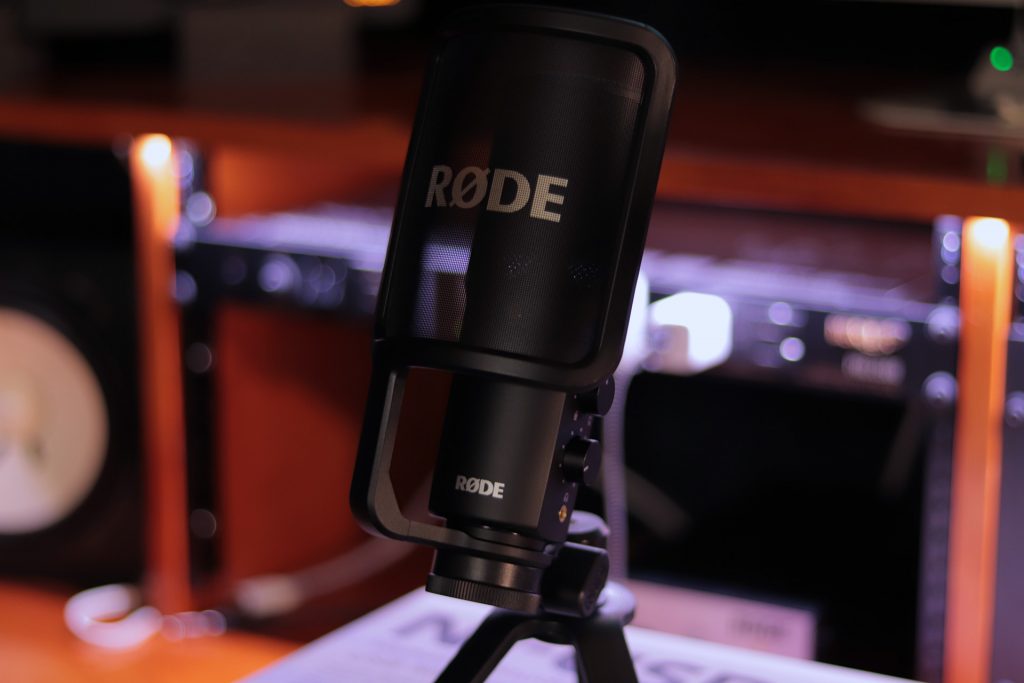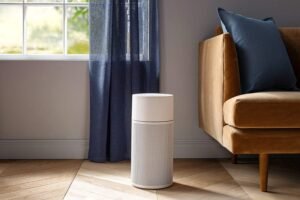
This is the review of the comparison between two microphones from two popular brands. The comparison here is between the Blue Yeti and the Rode NT-USB. There is around forty dollars difference in their price range and also, there is a difference in their features and performances. To know which one is better than the other, go to the detailed review.
 |  |
| Blue Yeti | Rode NT-USB |
| BUY NOW | BUY NOW |
| PROS | PROS |
| Multiple recording patterns. THX-certified sound quality. Record directly to your PC without an audio interface. Fantastic for the price. | Ease of use via USB connectivity. Good at filtering out background noise. Thoughtful design. |
| CONS | CONS |
| No multi-head setup. The wobbly plastic knobs make us wary about durability. No XLR output on the standard version. | Picks up table knocks and keystrokes. Only one polar pattern. |
SPECIFICATIONS:
| HEADER | BLUE YETI | RODE NT-USB |
| Brand | Blue Microphones | Rode |
| Product Line | Blue Microphones Yeti | Rode NT-USB |
| Model | Rode NT-USB | |
| GENERAL | BLUE YETI | RODE NT-USB |
| Manufacturer | Logitech | Rode |
| Recommended Use | Professional audio – instrument, vocal, voice, recording | |
| MICROPHONE | BLUE YETI | RODE NT-USB |
| Microphone Technology | electret condenser | condenser |
| Microphone Operation Mode | cardioid / omni-directional / bi-directional (switchable), stereo | cardioid |
| Sensitivity | ||
| Microphone Power Source Voultage (DC) | ||
| Frequency Response | 20 Hz | 20 Hz-20kHz |
| Signal-To-Noise Ratio | 120 db | |
| Total Harmonic Distortion (THD) | 0.5% | |
| Max Sound Pressure | 120 db | 110 db |
| Audio Input Details | Cardioid / omni-directional / bi-directional (switchable) – 20 – 20000 Hz | Cardioid – 20 – 20000 Hz |
| Connectivity Technology | Wired | Wired |
| AUDIO SYSTEM | BLUE YETI | RODE NT-USB |
| Type | Microphone | Microphone |
| Recommended Use | Professional audio | |
| Specific Applications | Instrument, recording, vocal, and voice | |
| Additional Functions | Amplifier | |
| Controls | Mute, volume | |
| DIMENSIONS & WEIGHT | BLUE YETI | RODE NT-USB |
| Component | microphone, microphone stand | |
| Width | 4.7 in | 2.4 in |
| Depth | 4.9 in | 2 in |
| Height | 11.6 in | 7.2 in |
| Weight | 19.4 oz, 2.2 lbs | 1.1 lbs |
| FEATURES | BLUE YETI | RODE NT-USB |
| Features | Tri-capsule Array – 3 Condenser Capsules Can Record Almost Any Situation. Multiple Pattern Selection – Cardioid, Bidirectional, Omnidirectional & Stereo. Gain Control, Mute Button, Zero-latency Headphone Output. Perfect for vocals, musical instruments, podcasting / Podcasts, voiceovers, interviews, field recordings, conference calls, streaming, gaming, and gaming commentary. Plug and play – Mac OS X (10.4.11 or Higher) and PC (Windows 8.1, 8, 7, Vista, XP). | ENSURE YOU BUY GENUINE RØDE: Products from sellers which say ‘fulfilled by Amazon’ under the price are NOT authorized resellers, and may not be selling genuine product. Buy only from Amazon.com (labelled ‘shipped and sold by Amazon.com’) High quality studio microphone with the convenience of USB connectivity. Pop shield, Tripod desk stand, ring mount, storage pouch and 6m (20’) USB cable included. 3.5mm stereo headphone jack for zero-latency monitoring. |
Detail Review:
INTRODUCTION:
Blue Yeti
The Blue Yeti is one of the popular microphones in the market which is also retailing for an affordable price of around a hundred and thirty dollars currently. This microphone comes with three condensers that’s how this mic performs four polar patterns.
Rode NT-USB
By the fact that USB is actually in this microphone’s name, you could probably deduct that it is a USB microphone. This microphone will run you for about a hundred and seventy dollars but it does have some pretty nice accessories that come with it.

DESIGN:
Blue Yeti
If you pop the top of this microphone off you’d actually see three condenser capsules, which are basically just microphones. This microphone itself also comes with a mute button, so if you hit the mute button it’ll flash meaning it’s muted, and if it’s live it’ll just have a glowing red light. You will actually see the gain indicator which is right there on the microphone itself and I’ve set mine to 25 because this microphone is really sensitive and it picks up almost everything. The Blue Yeti microphone also gives you four different types of recording patterns that you can use, and that is visible on the little switch dial on the back of the microphone.
There is also a volume knob, so you can adjust the sound in your ears so you can really hear how much is coming out of the microphone. On the other side of the mic, there is a gain switch which you need to be careful with because if you put it up too high it really can blow out as this microphone is really sensitive. So, I suggest you set it between low and 25 percent. If you don’t change that setting you’re gonna get a lot of different background noise on this microphone. It does have a couple of set screws that allow you to actually adjust your angle and position of the mic. At bottom of the mic is where you have got your headphone jack and the port to connect USB to your computer.
Rode NT-USB
This microphone really looks very nice, the knobs on it are fantastic, and the pop filter is also very nice. On the side of this microphone, you will see a knob that has a little microphone icon, and a little computer icon. Essentially, this knob is giving you the decision whether you want to hear direct monitoring from your microphone itself, or the signal from your computer and also, you can decide somewhere in between.
This does come with a headphone jack for direct monitoring, zero-latency monitoring. The knob below that is just your headphone volume control, and this does not come with a gain control knob on the actual microphone itself. When it comes to the build quality of the Rode NC-USB, this is actually built really well, and I would say it’s on par with some of Rode’s other condenser microphones like the NT1-A or the NT1.
When it comes to USB condenser microphones, there are a lot of them out there and when it comes to prices of those microphones, there are far cheaper ones than this absolutely. It’s just a little too pricey for the average person to want to get this microphone to start out with. When it comes to the build quality of this microphone and all the accessories, I think it is a big win. Other than the tripod desk stand, I love everything else and I think it’s built extremely well. The grille is super sturdy, I mean the pop filter isn’t like the most sturdy thing but it’s not gonna break or anything.

FEATURES:
Blue Yeti
When you buy this microphone, you get a nice fancy box which has got all kinds of marketing material, you also get a USB cable inside the box. So, this is a USB-powered microphone which pretty much means it’s compatible with any PC, Windows 7, Windows 10, Windows XP, Windows Vista, and even the Mac iOS operating system.
You want it to be 90 degrees from your voice and generally, I’m not using a pop filter which should prevent all the popping noises but I just like to speak slightly to the right-hand side so, you don’t need a pop filter. This is one of the best microphones to use for podcasting, music recording, twitch streaming, and even making your own youtube videos.
You also get a mic gain control, which controls the volume that actually the microphone sends to the computer. So, if you’re in an environment where the person is talking really softly, you can adjust the gain, if there’s a lot of background noise and you want to decrease that gain any noise like typing on a computer, or bumping anything, this kind of microphone would be ideal for that because you can actually set your pattern as well as your gain input going into your computer, which is the latest stage you could adjust.
One more awesome feature in the Blue Yeti is it also comes with a 3.5-millimeter audio adapter on the bottom, which allows you to actually listen to your voice in real-time. So, if you were doing a voiceover for a youtube video, or a podcast, for example, you’d have pretty good sound. All you need to do is plug the headphones on the bottom and now you can actually hear every single word you are saying live in real-time which is pretty awesome. This is one of the features that has made the Blue Yeti so popular among so many people.
Rode NT-USB
When you purchase the Rode NT-USB microphone, it will come with a pop filter, it will come with a mic mount as well as a microphone stand adapter, it will come with a very long USB cable, it also includes a nice leather padded carrying pouch, and it comes with a tripod desktop stand as well as a big Rode sticker. I do think a lot of USB microphones are solid and they are a good option for people that are just getting started out with podcasting, streaming on Twitch, etc. This one is kind of particularly interesting in the sense that it is actually about a hundred and seventy dollars, so it’s right out of the price range of being somewhat reasonable like the Blue Yeti microphone which comes in around 120 to 130 dollars.
I do not recommend using this with other desktop tripod stands, if you’re going to use this on your desk you’re going to pick up a lot of noise if you’re typing on your keyboard or moving, anything around. Another big issue is the fact that you can’t really get the microphone where it needs to be on by your mouth. The way to set your gain is in your manual but if you essentially just go into your system settings, and find your sound settings you can decide how loud you want your input to be.
The Rode NT-USB is a cardioid condenser microphone with a pressure gradient acoustic principle. This microphone has the ability to record up to 16 bits at 48 kilohertz. The frequency response of this microphone is 20 Hertz to 20 kilohertz, the dynamic range is 96 decibels, and it has a maximum SPL of a hundred and ten decibels. When looking at the frequency response of this microphone, it’s relatively somewhat flat for the most part but also, there is a boost at the high end, just because of what kind of microphone it is and what they expect people to use it for. I don’t really have a problem with the boost in the high end, it is pretty aggressive it’s about eight decibels but this microphone doesn’t sound too harsh to me. It is relatively bright though but I feel like they did a pretty good job with the frequency response.

PERFORMANCE:
Blue Yeti
Technically you’re supposed to speak with this really close at 90 degrees to the microphone. Hopefully, I don’t have any peep noises, if I do have that a little bit to the left-hand side. This microphone would be ideal, if you’re doing voiceovers on your youtube videos, maybe you want to start a podcast, this thing is the one to get.
The Blue Yeti performs four modes of polar patterns. The first pattern is the cardioid pattern it basically only records your voice in a particular heart patterned region and blocks anything from behind. This mode is ideal for youtube videos but also for podcasting where you don’t want to get background noise. The next mode is the stereo mode, the stereo mode is pretty useful it records from both the left and the right channels and gives you a much more fuller sound, and it won’t record from front and behind. This is ideal if you’re doing musical instruments maybe recording some vocals.
Another mode this microphone has is a bi-directional mode that’s actually useful if you want to do an interview type thing. So, it’ll pick up your voice from the front side and whoever you’re interviewing it’ll pick up their voice from the backside, and anything from the sides will be rejected. There is one more mode on this and that’s omnidirectional recording. That just means it records all around the microphone, which is nice if you’re doing some kind of nature walk and you want to record the environment, maybe you’re at a live concert and you want to record the music in the entire ambiance of the theater, that’s the kind of mode you want to use. This microphone performs all these modes pretty well.
Rode NT-USB
When it comes to the performance of this microphone I can say that I am happy with it. Overall, I do think it sounds good when you get a little bit closer to it. It’s definitely more on the bright side than dark but it’s good, and I like it. I feel like it has clarity but it’s not harsh. I will say the way that I would probably use this microphone most is in spoken-word situations for podcasting, or voiceovers, or things of that nature. I do feel like vocals in the songs and guitar are just a little too loud for it, I don’t feel like this is really a musician’s microphone.
I do think that for a USB condenser microphone 170 dollars is a little steep but I think that this is definitely worth looking at. I was honestly surprised when I plug this in and heard it. I felt like the noise level was very solid, I really enjoy the monitoring choices between hearing your computer or just the microphone. This does not have a gain knob on it, so it’d be so fantastic to have that on here.

WHICH ONE IS BETTER?
In my opinion, the Blue Yeti is better than the Rode NT-USB, because at a lower price than the Rode NT-USB the Blue Yeti has four polar patterns while the Rode NT-USB has only one polar pattern. Also, at a lower price, the Blue Yeti sounds better than the Rode NT-USB.
Expert Reviews of Blue Yeti:
By Podcastinsights
Even though the Blue Yeti tends to be popular with beginners (it was the first external microphone I bought), I find that it performs much better in the hands of someone slightly more experienced with audio recording.By TechRadar
The Blue Yeti is a great option for anyone who just wants to plug in and play without spending hours tweaking audio settings.By cnet
The Yeti is one of the richest sounding, sonically flexible USB microphones money can buy, but its large size makes it inconvenient for portable applications.By MusicRadar
For podcasting, streaming, and video conferencing, the Blue Yeti is still as simple and easy to use as ever. Highly recommended.By the podcast host
I think it’s a great option for someone looking for a simple set-up, but also a decent level of sound quality. The Yeti certainly sounds better than its little brother, the Blue Snowball, which is another popular starter microphone.Expert Reviews of Rode NT-USB:
By music radar
Your computer’s perfect partner for recording vocals and acoustic instruments with minimal fuss.By PC Gamer
Overall, if you’re serious about voiceover (be it for streaming, podcasts, or something else) and fancy dabbling in music as well, this is the ideal microphone. Brilliant audio-quality trumps the competition in almost…By microphone geeks
Overall, this mic simply rocks… it is relatively cheap but it beats the crap out of the competitors’ models at any time. Rode NT-USB is unarguably the best microphone of choice for today. Once you’ll have…By camaralabs
The Rode NT USB is a high-quality USB microphone designed to capture broadcast-quality vocals or music with a simple USB connection to your computer or laptop; indeed, with the supplied pop shield, tabletop stand, and long cable, you’re ready to record high-quality audio wherever…By Sound On Sound
USB mics are becoming increasingly common and affordable, but the quality varies. The Rode brand name, though, is one which instils a certain level of confidence with regard both to the quality of the engineering and the quality of the…




